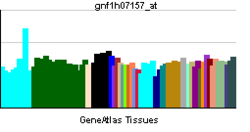- NIPA1
-
Non imprinted in Prader-Willi/Angelman syndrome 1 Identifiers Symbols NIPA1; FSP3; MGC102724; MGC35570; SPG6 External IDs OMIM: 608145 MGI: 2442058 HomoloGene: 42327 GeneCards: NIPA1 Gene Gene Ontology Cellular component • early endosome
• plasma membrane
• integral to membraneBiological process • ion transport
• cell death
• magnesium ion transportSources: Amigo / QuickGO RNA expression pattern 
More reference expression data Orthologs Species Human Mouse Entrez 123606 233280 Ensembl ENSG00000170113 ENSMUSG00000047037 UniProt Q7RTP0 Q3TLT5 RefSeq (mRNA) NM_001142275.1 NM_153578.2 RefSeq (protein) NP_001135747.1 NP_705806.1 Location (UCSC) Chr 15:
23.04 – 23.09 MbChr 7:
63.23 – 63.28 MbPubMed search [1] [2] Non-imprinted in Prader-Willi/Angelman syndrome region protein 1 is a protein that in humans is encoded by the NIPA1 gene.[1][2] This gene encodes a potential transmembrane protein which functions either as a receptor or transporter molecule, possibly as a magnesium transporter.[3] This protein is thought to play a role in nervous system development and maintenance. Alternative splice variants have been described, but their biological nature has not been determined. Mutations in this gene have been associated with the human genetic disease autosomal dominant spastic paraplegia 6.[4][5]
References
- ^ Rainier S, Chai JH, Tokarz D, Nicholls RD, Fink JK (Sep 2003). "NIPA1 gene mutations cause autosomal dominant hereditary spastic paraplegia (SPG6)". Am J Hum Genet 73 (4): 967–71. doi:10.1086/378817. PMC 1180617. PMID 14508710. http://www.pubmedcentral.nih.gov/articlerender.fcgi?tool=pmcentrez&artid=1180617.
- ^ "Entrez Gene: NIPA1 non imprinted in Prader-Willi/Angelman syndrome 1". http://www.ncbi.nlm.nih.gov/sites/entrez?Db=gene&Cmd=ShowDetailView&TermToSearch=123606.
- ^ Goytain A, Hines RM, El-Husseini A, Quamme GA (2007). "NIPA1(SPG6), the basis for autosomal dominant form of hereditary spastic paraplegia, encodes a functional Mg2+ transporter.". J. Biol. Chem. 282 (11): 8060–8. doi:10.1074/jbc.M610314200. PMID 17166836.
- ^ Reed JA, Wilkinson PA, Patel H, et al. (2005). "A novel NIPA1 mutation associated with a pure form of autosomal dominant hereditary spastic paraplegia.". Neurogenetics 6 (2): 79–84. doi:10.1007/s10048-004-0209-9. PMID 15711826.
- ^ Rainier S, Chai JH, Tokarz D, et al. (2003). "NIPA1 gene mutations cause autosomal dominant hereditary spastic paraplegia (SPG6).". Am. J. Hum. Genet. 73 (4): 967–71. doi:10.1086/378817. PMC 1180617. PMID 14508710. http://www.pubmedcentral.nih.gov/articlerender.fcgi?tool=pmcentrez&artid=1180617.
Further reading
- Bittel DC, Kibiryeva N, Butler MG (2006). "Expression of 4 genes between chromosome 15 breakpoints 1 and 2 and behavioral outcomes in Prader-Willi syndrome.". Pediatrics 118 (4): e1276–83. doi:10.1542/peds.2006-0424. PMID 16982806.
- Liu T, Qian WJ, Gritsenko MA, et al. (2006). "Human plasma N-glycoproteome analysis by immunoaffinity subtraction, hydrazide chemistry, and mass spectrometry.". J. Proteome Res. 4 (6): 2070–80. doi:10.1021/pr0502065. PMC 1850943. PMID 16335952. http://www.pubmedcentral.nih.gov/articlerender.fcgi?tool=pmcentrez&artid=1850943.
- Munhoz RP, Kawarai T, Teive HA, et al. (2006). "Clinical and genetic study of a Brazilian family with spastic paraplegia (SPG6 locus).". Mov. Disord. 21 (2): 279–81. doi:10.1002/mds.20775. PMID 16267846.
- Chen S, Song C, Guo H, et al. (2006). "Distinct novel mutations affecting the same base in the NIPA1 gene cause autosomal dominant hereditary spastic paraplegia in two Chinese families.". Hum. Mutat. 25 (2): 135–41. doi:10.1002/humu.20126. PMID 15643603.
- Chai JH, Locke DP, Greally JM, et al. (2003). "Identification of four highly conserved genes between breakpoint hotspots BP1 and BP2 of the Prader-Willi/Angelman syndromes deletion region that have undergone evolutionary transposition mediated by flanking duplicons.". Am. J. Hum. Genet. 73 (4): 898–925. doi:10.1086/378816. PMC 1180611. PMID 14508708. http://www.pubmedcentral.nih.gov/articlerender.fcgi?tool=pmcentrez&artid=1180611.
- Toyoda N, Nagai S, Terashima Y, et al. (2003). "Analysis of mRNA with microsomal fractionation using a SAGE-based DNA microarray system facilitates identification of the genes encoding secretory proteins.". Genome Res. 13 (7): 1728–36. doi:10.1101/gr.709603. PMC 403746. PMID 12805275. http://www.pubmedcentral.nih.gov/articlerender.fcgi?tool=pmcentrez&artid=403746.
- Strausberg RL, Feingold EA, Grouse LH, et al. (2003). "Generation and initial analysis of more than 15,000 full-length human and mouse cDNA sequences.". Proc. Natl. Acad. Sci. U.S.A. 99 (26): 16899–903. doi:10.1073/pnas.242603899. PMC 139241. PMID 12477932. http://www.pubmedcentral.nih.gov/articlerender.fcgi?tool=pmcentrez&artid=139241.
- Fink JK, Jones SM, Sharp GB, et al. (1996). "Hereditary spastic paraplegia linked to chromosome 15q: Analysis of candidate genes.". Neurology 46 (3): 835–6. PMID 8618696.
- Fink JK, Wu CT, Jones SM, et al. (1995). "Autosomal dominant familial spastic paraplegia: tight linkage to chromosome 15q.". Am. J. Hum. Genet. 56 (1): 188–92. PMC 1801321. PMID 7825577. http://www.pubmedcentral.nih.gov/articlerender.fcgi?tool=pmcentrez&artid=1801321.
Categories:- Human proteins
- Chromosome 15 gene stubs
Wikimedia Foundation. 2010.
